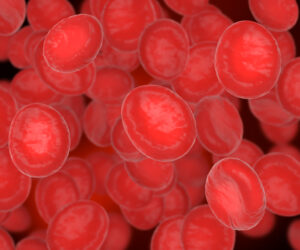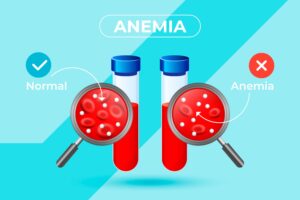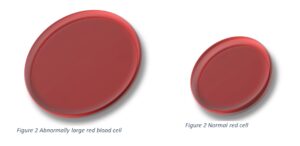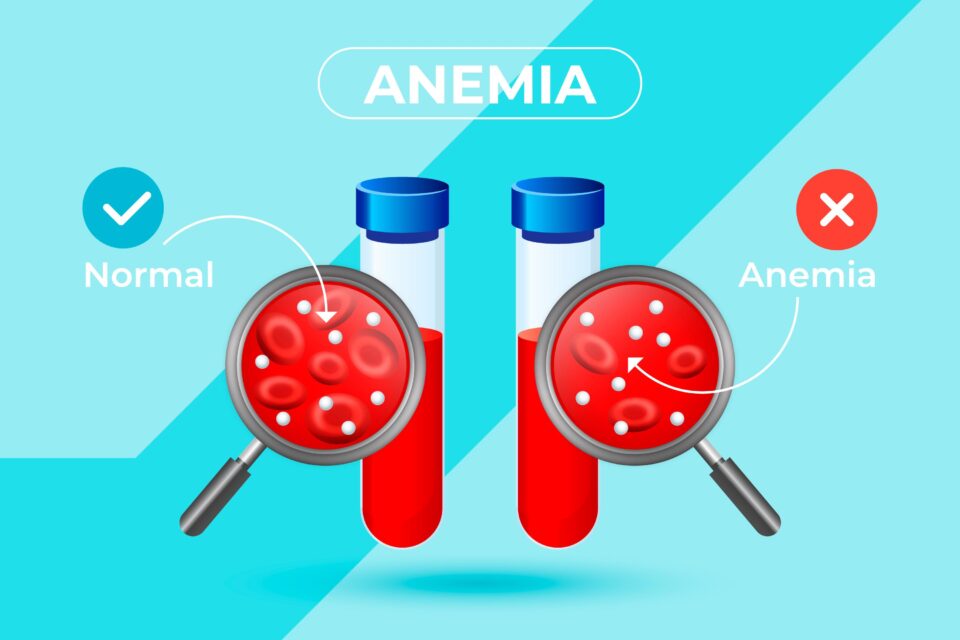What is Anaemia?
Anaemia is a non-communicable disease[1] which is characterized by a decrease in the amount of red blood cells or haemoglobin in the blood.
What is Haemoglobin?
Haemoglobin is a protein present in red blood cells that is responsible for transporting oxygen throughout our bodies.

Anaemia happens when there is a deficiency of haemoglobin or red blood cells, our body does not receive the sufficient amount of oxygen that it needs.

This can lead to several symptoms and complications such as:
- Constant fatigue
- Dizziness
- Headache
- Fainting
- Paleness
- shortness of breath
- feeling weak, exhaustion
- tachycardia (a resting heart rate over 100 beats per minute)
Types of nutrition-related anaemia
There are 2 types of anaemia which are a result of one of these micronutrient deficiencies: iron, vitamin B12, or folate (folic acid/vitamin B9). Aside from these nutrition-related anaemias, other possible causes could lead to anaemia, therefore it is important that if you suspect you have anaemia go see your GP first to get help in finding out what is the cause of your anaemia.
As a nutritionist, I will explain further about iron deficiency anaemia and the anaemia which occurs when there is a deficiency in Vitamin B12 or folate (folic acid/vitamin B9).
Iron deficiency anaemia!
Iron deficiency anaemia is the most common form of anaemia, and it is caused by a lack of iron in the body. Iron is a mineral which is vital for producing haemoglobin. Common causes of iron deficiency are:
- an iron-deficient diet
- poor iron absorption
- pregnancy
- childhood growth spurts
- blood loss due to menstruation or internal bleeding.
Megaloblastic anaemia
Megaloblastic anaemia is a type of anaemia is characterised by abnormally large red blood cells as a result these red blood cells do not function properly, and this type of anaemia happens when there is a vitamin B12 or folate deficiency.

Both Vitamin B12 and folate are essential vitamins in the production of your red blood cells.
A deficiency in vitamin B12 or folate (folic acid/vitamin B9) can be caused by:
- a poor diet
- a poor absorption of these vitamins
- or certain autoimmune diseases (e.g., pernicious anaemia)
Important to note: Heating foods during the cooking process will destroy any folic acid (folate) that it may contain.
Foods rich in Iron
First, it is important to note that there are 2 types of iron which we consume through food:
- Heme iron – found in animal food sources.
- Non-heme iron – found in plant sources.
Our bodies can absorb more easily heme iron compared to non-heme iron. According to Skolmowska et al., “Heme iron is highly bioavailable (25–30% of this form is absorbed), although it represents a minor part of dietary iron [14,15], while the absorption of non-heme iron is more variable (1–10% of this form is absorbed) [16].”
| Examples of Foods Rich in Iron | ||
| Meat and egg sources | Fish and Seafood sources | Plant sources |
| · Beef
· Lamb · Ham · Turkey · Chicken · Veal · Pork · Dried beef · Organ meat (e.g., Liver) · Eggs |
· Shrimp
· Clams · Oysters · Tuna · Sardines · Haddock · Mackerel
|
· iron-fortified bread and breakfast cereal
· nuts and seeds · dried fruit · wholemeal pasta and bread · Legumes — such as mixed beans, baked beans, lentils and chickpeas · dark leafy green vegetables — such as spinach, silver beet and broccoli
|
To improve the absorption of iron it is recommended:
- to eat foods high in vitamin C (e.g., tomatoes, citrus fruits, bell peppers, especially red, yellow, and orange.
- to have foods with vitamin A in your diet because vitamin A helps our bodies release our stored iron.
- For those who eat meat or fish or both it is recommended to combine animal protein which contains heme iron with plant sources of non-heme iron, this will increase the amount of available iron sources for absorption and provide a balanced meal.
What reduces the absorption of iron?
- tannins (e.g., tea, coffee, or wine)
- soy protein affects the absorption of iron due to its phytic acid (also known as phytate, is a natural antioxidant and is a storage form of phosphorus. It is also present in seeds, grains, and nuts) content.
- Calcium and phosphorus
- Inadequate levels of vitamin A
Foods rich in Vitamin B12 and Folate (Vitamin B9)
Animal sources are the only source of vitamin B12. Here are some examples of excellent sources of vitamin B12:
- Oysters, clams, and mussels are amazing sources of vitamin 12.
- Liver and organ meats are packed with B vitamins (thiamine, riboflavin, niacin, vitamin B5, vitamin B6, biotin, folate, and vitamin B12)
- Eggs also contain a variety of B vitamins although less than liver.
- Milk is a good source of B12 vitamin.
Aside from the animal sources that contain vitamin B9. An excellent source of vitamin B9 (folate/folic acid) is leafy greens: e.g., spinach, collard greens, turnip greens, and romaine lettuce.
References
- Skolmowska, Dominika, and Dominika Głąbska. “Analysis of Heme and Non-Heme Iron Intake and Iron Dietary Sources in Adolescent Menstruating Females in a National Polish Sample.” Nutrients 11,5 1049. 10 May. 2019, doi:10.3390/nu11051049
[1] A non-communicable disease is a disease that is not transmissible directly from one person to another. Non-communicable diseases include autoimmune diseases, strokes, hypertension, anaemia, type 2 diabetes, etc.

